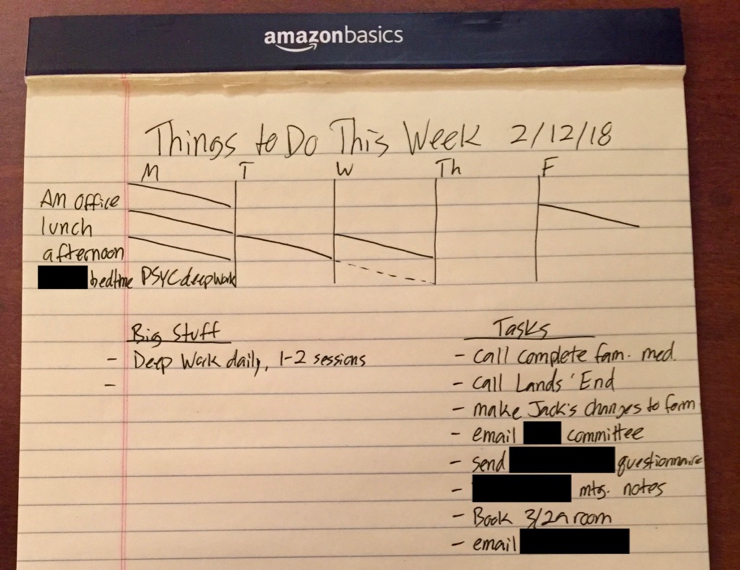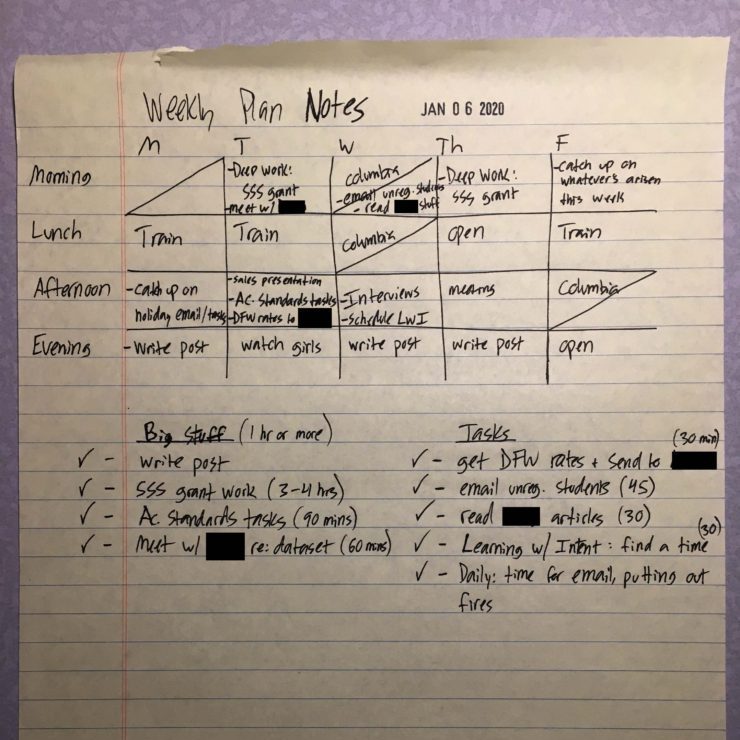How to Plan Your Week
Nerd Emperor here.1
We’ve talked before about why planning your day the night before is the bee’s knees. It helps you get the important stuff done, and it saves you from spending your “doing” time deciding what to do.
About nine months ago, spurred by a blog post by Cal Newport, I took things a step further and began planning my week. Friend, I’m here to tell you that the benefits conferred by daily planning are multiplied by weekly planning.
Below, I’ll walk you through how I plan my week before concluding with a discussion of what weekly planning delivers that daily planning can’t.
Let’s dive in.
Step 1: Sketch it out
 A half-finished plan from a few months ago
A half-finished plan from a few months ago
My method is low-tech yet effective.
I start with a sheet of paper titled “Things I Get to Do This Week,” a heavy-handed title designed to remind me that I’m in charge of my time and my actions. I don’t have to do anything. It does me good to remember this.
I make a rough grid, with the columns labeled with the days of the week and four rows labeled “Morning,” “Lunch,” “Afternoon,” and “Evening.” I put a line through any time slots that are unavailable due to other commitments.
Below that, I create two unrelated columns: “Big Stuff” (60 minutes or more) and “Tasks.” Using my calendar, my Next Actions list, and my memory, I list everything I plan to do this week in one column or the other. Next—and this is the key to the whole system—I assign each item to an empty slot in the grid above (Big Stuff often get its own block, while Tasks are batched together).
[caption id=“attachment_3780” align=“aligncenter” width=“740”] A finished weekly plan (from a different week).[/caption]
A finished weekly plan (from a different week).[/caption]
This process forces me to take a sober look at how many free hours await me in the coming week. Often, I run out of time and have to reshuffle priorities. Some weeks, I have empty time slots left over. Nice!
Step 2: Type it up, revise
Next, I turn this messy grid into a narrative.2
I create a .txt file titled YYYY-MM-DD-weekly-plan.txt in which I describe what each day will look like. Below are three days from a fairly typical weekly plan. For context, it’s helpful to know that I’m a university academic advisor who’s taking undergraduate courses to prepare for PhD work.
Tuesday
In the afternoon, find time between advising appointments to process office email. If necessary, stay a little late to get it done. On the walk home, call Mom.In the evening, head to weekly trivia with Sarah and [daughter]. After putting [daughter] to bed, write today’s blog post and log at least 30 minutes of deep work reviewing Anki.
Wednesday
First thing at the office, launch a major statistics deep work block of two hours. Review Anki, then aim to complete homework 8.2. Use the rest of the morning to process office email and take care of minor tasks.At lunch, make an audiology appointment and [complete minor household task].
At [daughter’s] bedtime, log a psychology deep work block. Do Anki, review the paper assignment so I can suggest a structure to [paper co-author], and start the exam study guide.
Thursday
First thing at the office, launch a major statistics deep work block of 1.5 hours. Review Anki and do an assortment of questions from prior chapters in MyStatLab.At lunch, write a blog post.
In the afternoon during walk-in hours, quickly review my Science of Learning presentation before giving it at 3. After the presentation, go see [psychology professor] for feedback on my two-year course plan.
At [daughter’s] bedtime, launch a psychology deep work block. Start with Anki, then split the rest of the time between starting on the paper assignment and reviewing the study guide.
This step—typing my week out in story form—may seem superfluous, but it does wonders to keep me motivated each evening as I plan the next day. The entire process takes about an hour each Sunday evening (or Monday morning).
When plans need to change mid-week (as they sometimes do), I just duplicate the .txt file and replan the rest of the week accordingly.
Step 3: Write daily plans based on the weekly plan
A weekly plan makes daily planning so much easier. It only takes ten minutes each evening to reference the weekly plan and translate the next day’s entry into a series of 30-minute time slots.
Why weekly planning is worth it
You may be thinking, “I see how weekly planning could be helpful. But it seems like an awful lot of work.”
It’s less work than you might imagine, but you’re not wrong. I’ll admit that I’m often less than enthused about taking an hour out of my Sunday evening to plan my week. But as with so many things in life, this practice pays off later.
We all know the guilty feeling of putting off an important but irksome task. “I’ll call the client tomorrow,” we tell ourselves, knowing full well that we’ll probably tell ourselves the same thing tomorrow. Daily planning allows for this strain of procrastination, but weekly planning stops it cold. When you plan your week, you decide when, exactly, you’re doing to tackle the worst stuff on your plate. You sleep better knowing it’s accounted for in your schedule—Wednesday afternoon: call client—and when the moment arrives, you know you have to execute. After all, the rest of your week is now full of other commitments.
Productivity is highly individualized, and what works for me might not work for you. But if you’re reasonably faithful with planning your day, try planning your week. You’ll likely find the results worth the effort.
- My wife recently called me a “Nerd Emperor” after reading this McSweeney’s article on MBTI types. I protested, of course, but here I sit writing an article extolling the virtues of planning your entire week. All hail the Nerd Emperor! ↩
- Both the method I’m describing here and this post itself are strongly influenced by the Cal Newport post I referenced at the top of the page. Props, once more, to Cal. Check out his blog and buy his best book. ↩